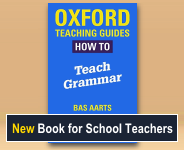Clause types: statements, questions, commands and exclamations
The National Curriculum recognises four clause types (also called ‘sentence types’ ). They are usually used to ‘do different things’. These are statements, questions, commands and exclamations.
Each clause type has its own typical pattern (i.e. word order).
In statements, the Subject comes in its typical position before the verb. Here are some examples:
- We had a very good turnout. [S1A-005 #212]
- The Labour Party doesn’t want a war. [S1B-035 #33]
- Officially I was doing a unit of English. [S1A-006 #11]
Questions also have a special word order, where the Subject comes after a verb. In other cases words such as what, who, when, where, why or how are used. Here are some examples:
- Are you planning parties? [S1A-019 #350]
- Does she play tennis? [S1A-020 #221]
- Are you cold? [S1A-080 #265]
- When did you get married? [S1A-056 #230]
- Who told you that? [S1A-059 #15]
- How much is she getting paid? [S1A-041 #162]
Commands are typically used to tell someone to do something. These clauses have no Subject. Here are some examples.
- Leave that battery alone. [S1A-007 #184]
- Try again. [S1A-044 #162]
- Be alert when out and about. [W2D-009 #53]
To tell someone not to do something, we can put don’t before the main verb: Don’t tell Kate; Don’t be mean. These are negative commands.
Exclamations are used to express surprise, delight, etc. They generally start with a phrase containing what or how. This phrase comes first even when it is not the Subject, which often gives a special word order.
- What a labyrinth of lies and half-truths was closing around her! [W2F-003 #108]
- How true that is! [S1A-079 #116]
The National Curriculum stipulates that questions must have an question mark after them, and exclamations must have an exclamation mark.
Please be aware that the fact that exclamations must have an exclamation mark does not mean that other kinds of clauses can't have an exclamation mark. For example, if I write It's a lovely day! then the pattern is that of a statement, not an exclamation. The pattern for the latter would be What a nice day it is!
Note: It would have been better for the National Curriculum to have used one set of terms for structure (declarative, imperative, interrogative, exclamative) and another set of terms for meaning (statement, command, question, exclamation), as most linguists do (see e.g. Bas Aarts's Oxford Modern English Grammar).
Welcome!

Englicious is totally free for everyone to use!
But in exchange, we ask that you register for an account on our site.
If you’ve already registered, you can log in straight away.
Since this is your first visit today, you can see this page by clicking the button below.
- Printer-friendly version
- Log in to view or leave comments

